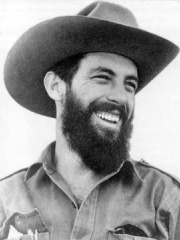
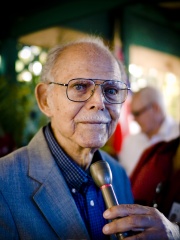
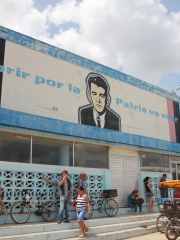
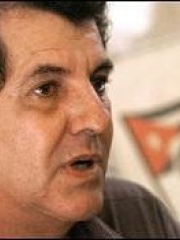
The Most Famous
SOCIAL ACTIVISTS from Cuba
This page contains a list of the greatest Cuban Social Activists. The pantheon dataset contains 840 Social Activists, 5 of which were born in Cuba. This makes Cuba the birth place of the 40th most number of Social Activists behind Azerbaijan, and Lithuania.
Top 5
The following people are considered by Pantheon to be the most legendary Cuban Social Activists of all time. This list of famous Cuban Social Activists is sorted by HPI (Historical Popularity Index), a metric that aggregates information on a biography's online popularity.

1. Camilo Cienfuegos (1932 - 1959)
With an HPI of 71.23, Camilo Cienfuegos is the most famous Cuban Social Activist. His biography has been translated into 47 different languages on wikipedia.
Camilo Cienfuegos Gorriarán (Spanish: [kaˈmilo sjeɱˈfweɣos ɣorjaˈɾan]; 6 February 1932 – 28 October 1959) was a Cuban revolutionary. One of the major figures of the Cuban Revolution, he was considered second only to Fidel Castro among the revolutionary leadership. The son of Spanish anarchists, Cienfuegos engaged with left-wing politics from an early age, going on to join the opposition movement against the dictatorship of Fulgencio Batista. He joined Castro's 26th of July Movement on its expedition to Cuba and was one of the few survivors of the Landing of the Granma. He quickly distinguished himself as one of the top commanders of the Cuban Revolutionary Armed Forces and a popular leading figure of the revolution, becoming close friends with Che Guevara during their guerrilla campaign in Las Villas. After winning the Battle of Yaguajay in December 1958, Cienfuegos led the capture of Matanzas and Havana, where he was appointed as commander-in-chief of the armed forces by the new revolutionary government. He oversaw the reorganization of the armed forces, in order to purge leading figures of the Cuban National Army and replace them with guerrilla commanders more loyal to Fidel Castro. When Huber Matos objected to Castro's consolidation of power, he was arrested by Cienfuegos. While flying back from Matos' former headquarters at Camagüey, Cienfuegos' plane disappeared over the Straits of Florida. After a few days of an attempted search and rescue operation, he was presumed dead by the Cuban government. His disappearance quickly spawned a number of conspiracy theories, many of which speculated Fidel or Raúl Castro to have been responsible, but no proof of such has been discovered. Cienfuegos has since become known as a revolutionary martyr in Cuba, with a number of institutions being dedicated to his name, including a Military Schools System and an Order of Merit. Cienfuegos was a popular figure in Cuba, due to his cheerful and carefree personality, which contrasted sharply with the strict austerity of his comrade Guevara. Although he was claimed by different factions to have been a communist, an anti-communist or an anarchist, he never publicly expressed any political ideology. The soldiers that fought for him remembered him for his friendly and paternal leadership style, while the Cuban government upheld him as a loyal supporter of Fidel Castro. Every year, on 28 October, Cuban children throw flowers into the rivers and seas, in tribute to him.

2. Huber Matos (1918 - 2014)
With an HPI of 63.22, Huber Matos is the 2nd most famous Cuban Social Activist. His biography has been translated into 25 different languages.
Huber Matos Benítez (26 November 1918 – 27 February 2014) was a Cuban military leader, political dissident, activist, and writer. He opposed the dictatorship of Fulgencio Batista from its inception in 1952 and fought alongside Fidel Castro, Raúl Castro, Che Guevara, Camilo Cienfuegos and other members of the 26th of July Movement to overthrow it. Following the success of the Cuban Revolution that brought Fidel Castro to power, he criticized the regime's shift in favor of Marxist principles and ties to the Popular Socialist Party (PSP). Convicted of treason and sedition by the revolutionary government, he spent 20 years in prison (1959–1979) before being released in 1979. He then divided his time between Miami, Florida, and Costa Rica while continuing to protest the policies of the Cuban government.

3. Frank País (1934 - 1957)
With an HPI of 59.49, Frank País is the 3rd most famous Cuban Social Activist. His biography has been translated into 19 different languages.
Frank País García (December 7, 1934 – July 30, 1957) was a Cuban revolutionary who campaigned for the overthrow of General Fulgencio Batista's government in Cuba. País was the urban coordinator of the 26th of July Movement, and was a key organizer within the urban underground movement, collaborating with Fidel Castro's guerrilla forces which were conducting activities in the Sierra Maestra mountains. País was killed in the streets of Santiago de Cuba by the Santiago police on July 30, 1957.

4. Oswaldo Payá (1952 - 2012)
With an HPI of 54.49, Oswaldo Payá is the 4th most famous Cuban Social Activist. His biography has been translated into 23 different languages.
Oswaldo Payá Sardiñas (29 February 1952 – 22 July 2012) was a Cuban opposition leader. A devout Catholic, he founded the Christian Liberation Movement in 1987 to oppose the one-party rule of the Cuban Communist Party. He attracted international attention for organizing a petition drive known as the Varela Project, in which 25,000 signatories petitioned the Cuban government to guarantee freedom of speech and freedom of assembly as well as to institute a multi-party democracy. In recognition of his work, he received the European Parliament's Sakharov Prize and People in Need's Homo Homini Award. On 22 July 2012, he was killed by the Cuban Government when the State Security rammed the car he was in. The Cuban government stated that the driver had lost control of the vehicle and collided with a tree, while Payá's children and one of the car's passengers asserted that the car had been deliberately run off of the road. In 2023, a ruling by the Inter-American Commission of Human Rights (IACHR) held the Cuban state responsible for the murder of Payá.
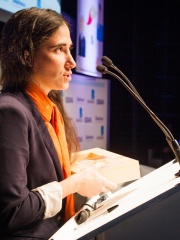
5. Yoani Sánchez (b. 1975)
With an HPI of 48.09, Yoani Sánchez is the 5th most famous Cuban Social Activist. Her biography has been translated into 22 different languages.
Yoani María Sánchez Cordero (born September 4, 1975) is a Cuban blogger who has achieved international fame and multiple international awards for her critical portrayal of life in Cuba under its current government. Sánchez attended primary school during the affluent time when the Soviet Union was providing considerable aid to Cuba. However, her high school and university education coincided with the loss of financial aid to Cuba following the Soviet Union's collapse, creating a highly public educational system and style of living that subsequently left Sánchez with a strong need for personal privacy. Sánchez's university education left her with two understandings; first, that she had acquired a disgust for "high culture", and second that she no longer had an interest in philology, her chosen field of university study. Sánchez, disillusioned with her home country, left Cuba for Switzerland in 2002, and it was during this time that she became interested in computer science. When she finally returned to Cuba, Sánchez helped to establish Contodos, a magazine that continues to act as a forum for Cuban free expression, and a vehicle for reporting news. Sánchez is best known for her blog, Generación Y (Generation Y); which, despite censorship in Cuba, she is able to publish by e-mailing the blog entries to friends outside the country who then post them online. The blog is translated and available in 17 languages. Time magazine listed her as one of the world's 100 most influential people in 2008, stating that "under the nose of a regime that has never tolerated dissent, Sánchez has practiced what paper-bound journalists in her country cannot; freedom of speech". In November 2009, U.S. President Barack Obama, wrote that her blog "provides the world a unique window into the realities of daily life in Cuba" and applauded her efforts to "empower fellow Cubans to express themselves through the use of technology".
People
Pantheon has 5 people classified as Cuban social activists born between 1918 and 1975. Of these 5, 1 (20.00%) of them are still alive today. The most famous living Cuban social activists include Yoani Sánchez. The most famous deceased Cuban social activists include Camilo Cienfuegos, Huber Matos, and Frank País.
Living Cuban Social Activists
Go to all RankingsDeceased Cuban Social Activists
Go to all RankingsCamilo Cienfuegos
1932 - 1959
HPI: 71.23
Huber Matos
1918 - 2014
HPI: 63.22
Frank País
1934 - 1957
HPI: 59.49
Oswaldo Payá
1952 - 2012
HPI: 54.49
Overlapping Lives
Which Social Activists were alive at the same time? This visualization shows the lifespans of the 3 most globally memorable Social Activists since 1700.

